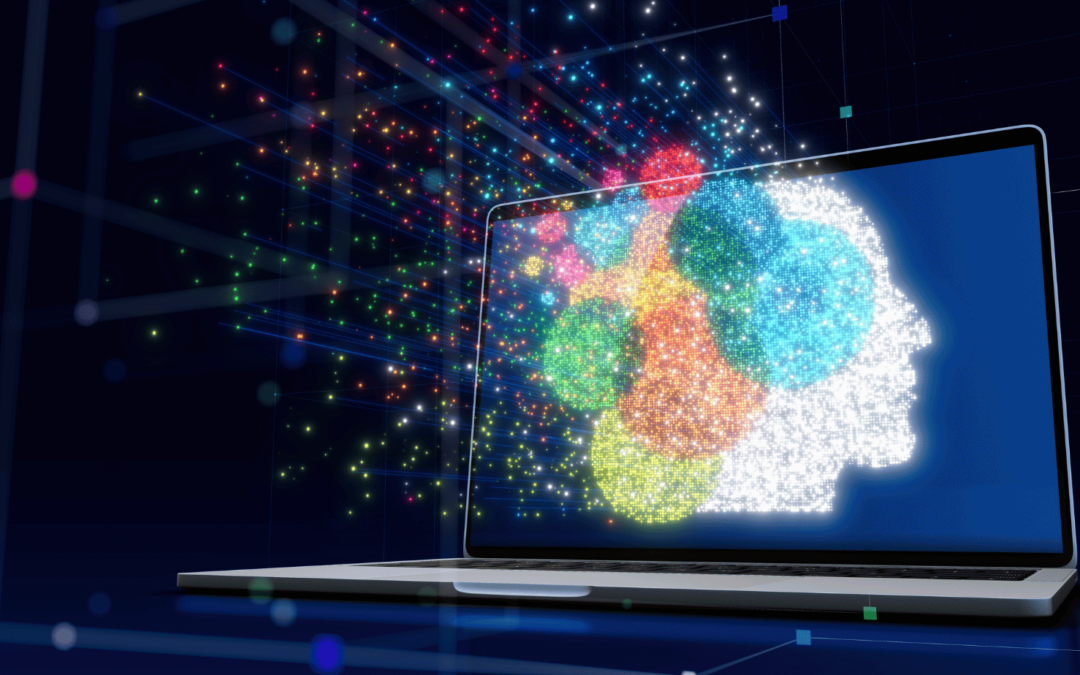As an avid admirer of all things AI, I’ve had the privilege to observe and mull over the emergence of a truly captivating field – generative artificial intelligence. Much like an artist’s brush dancing across a canvas, generative AI breathes life into technology in dynamic and innovative ways.
Its abilities range from producing text that mirrors human conversation to crafting unique designs or concepts. It stands proudly as a lighthouse for innovation and creativity in this digital age.
To simplify: it’s much like having your own personal Picasso on hand, capable of creating one-of-a-kind masterpieces in just minutes! Now join me as we venture deeper into this riveting domain where artistry intertwines with AI.
Key Takeaways
- Generative AI is a fascinating field that combines artificial intelligence and creativity, allowing machines to generate original content that mimics human-like behavior.
- Neural networks play a crucial role in generative AI by spotting patterns in data and creating new outcomes based on those patterns. This technology powers popular models like Dall-E, ChatGPT, and Bard.
- Generative AI has wide – ranging applications, such as creating synthetic data for AI training and generating creative content for marketing and entertainment. It also enables the development of new tools tailored to different industries’ needs.
- The benefits of generative AI include increased efficiency and productivity through task automation, as well as unlocking creativity by generating unique content. However, ethical concerns related to biases in generated content need to be addressed.
What is Generative AI and How Does it Work?

Generative AI, a fascinating field at the intersection of artificial intelligence and creativity, has revolutionized the way we think about AI technology. By leveraging powerful neural networks and complex algorithms, generative AI models can generate original content that imitates human-like behavior.
These models are trained on massive datasets and learn patterns, enabling them to produce new and unique outputs based on those patterns. From art creation to text generation, generative AI is pushing the boundaries of what machines can accomplish.
Generative AI models and their capabilities
Generative AI models have a special power. They can make new content like text, sound, pictures and even synthetic data. These models learn from things that are already there to create new stuff that looks real.
Even better, they save time by mixing and looking at data from many places all by themselves. Tech giants use deep learning and Generative Adversarial Networks (GANs) for this magic! Say you want human-like language or code – generative AI models like ChatGPT can do it for you! The best part? You will find these in all kinds of work areas where they help businesses grow big and strong.
Role of neural networks in generative AI
Neural networks are key players in the world of generative AI. They spot patterns in data like a hawk spots a mouse. From these patterns, they come up with new outcomes that weren’t there before.
Take for example, language creation or image making. The neural network dives into tons of words and pictures. It learns the common trends it sees in this pool of stuff and uses what it has learned to create something new! Be it fresh sentences or unseen images; they’re all the fruit of neural networks running under generative AI’s hood!
Popular generative AI models (Dall-E, ChatGPT, Bard)
Let’s dive into the amazing world of generative AI. I want to share with you some popular models.
- Dall-E: This model is a star player in our world! It creates images from text. All you need to do is tell it what you want, and like magic, Dall-E draws it for you.
- ChatGPT: This model is your talk buddy. It uses a tool called the Chat Generative Pre-Trained Transformer. This helps it chat in a way that feels real.
- Bard: This newbie also deserves a mention. It’s still learning but has shown great signs of promise.
Applications of Generative AI

Unlocking the Boundless Possibilities
Generative AI has a wide range of applications that are revolutionizing various industries. From creating synthetic data for AI training to generating creative content for marketing and entertainment, this powerful technology is reshaping the way we work and interact with AI systems.
Additionally, generative AI is being utilized to develop new tools and solutions across different sectors. Let’s delve deeper into the exciting applications of generative AI and explore how it is transforming the technological landscape.
Creating Synthetic Data for AI Training:
One remarkable application of generative AI lies in its ability to create synthetic data for training machine learning models. Traditional methods of collecting large amounts of labeled data can be time-consuming, expensive, or even impractical in certain scenarios.
Generative models can help address this issue by generating realistic and diverse datasets that simulate real-world scenarios. This enables developers to train their AI models more efficiently while reducing costs and reliance on manually collected data.
Generating Creative Content for Marketing and Entertainment:
Generative AI is
Creating synthetic data for AI training
Creating synthetic data for AI training is a powerful application of generative AI. With sophisticated techniques, Generative AI can generate synthetic data that mimics the structure, features, and characteristics of real data.
This synthetic data is valuable for testing machine learning models and developing software applications without privacy concerns. By using generative AI to create realistic artifacts on a large scale, researchers and developers can train their AI systems more effectively and efficiently.
Synthetic data allows them to explore different scenarios and edge cases that may not be readily available in real-world datasets. It helps improve the performance and accuracy of AI models by providing diverse training examples.
Generating creative content for marketing and entertainment
Generative AI is revolutionizing the way we create content for marketing and entertainment. With generative AI, we can easily generate creative and engaging materials that attract customers and entertain audiences.
This technology allows us to create various forms of content like images, text, audio, videos, and even simulations.
In marketing, generative AI can be used to generate personalized advertisements based on customer preferences or create compelling social media posts. It helps businesses save time by automating content creation processes, allowing marketers to focus on strategy and analysis.
In the entertainment industry, generative AI enables the production of unique music compositions or realistic computer-generated graphics for movies and games. It opens up new possibilities for artists to unleash their creativity and experiment with different styles.
Developing new tools for various industries
As a tech-savvy person interested in AI technology, you’ll be excited to know that generative AI is being used to develop new tools for various industries. OpenAI offers advanced AI models and tools that developers can use for this purpose.
These tools include Transformers, LangChain, Pinecone, Weights & Biases, BentoML, and Gradio. With the help of generative AI, developers can create innovative solutions tailored to different industries’ needs.
A McKinsey survey has shown that many workers across different industries have already tried using generative AI tools. This indicates a promising future for the development of new tools using generative AI technology.
Benefits and Limitations of Generative AI
Benefits of Generative AI: Unlocking Efficiency and Creativity
Generative AI offers a multitude of benefits, revolutionizing various industries and transforming the way we approach tasks. One key advantage is increased efficiency and productivity.
With generative AI models, businesses can automate repetitive tasks and streamline workflows. This not only saves time but also allows employees to focus on more strategic activities.
Moreover, generative AI has the potential to unleash creativity like never before. By using generative models such as Dall-E or Bard, companies can generate unique and original content for marketing campaigns or entertainment purposes.
From creating compelling visuals to developing music compositions, the possibilities are endless with generative AI.
Limitations of Generative AI: Addressing Ethical Concerns
While there are numerous benefits associated with generative AI, it is important to consider its limitations as well. One major concern revolves around ethics and bias in generated content.
Since these models learn from existing data sets, they may inadvertently replicate existing biases present in society.
Increased efficiency and productivity
Generative AI has the power to greatly improve efficiency and productivity in various industries. By using generative AI models, businesses can automate tasks and streamline processes, allowing employees to focus on more strategic and creative work.
With faster product development, improved customer experience, and enhanced decision-making processes, generative AI can lead to increased efficiency in business operations. Implementing generative AI technology in the workplace can result in significant time savings and improved productivity levels.
Potential for creativity and innovation
Generative AI has immense potential to foster creativity and drive innovation in various industries. By leveraging powerful neural networks, generative AI models can augment the creative capabilities of both employees and customers.
This technology enables the generation of new forms of content, such as audio, text, code, images, simulations, and videos. With generative AI, businesses can explore novel ideas and create cutting-edge products and experiences that were previously unimaginable.
One area where generative AI has made a significant impact is in the fields of art and music. Artists and musicians are utilizing this technology to push boundaries and create innovative works that captivate audiences.
For example, generative AI can compose unique pieces of music or generate stunning visual art based on specific criteria or styles. This allows for endless possibilities in terms of creativity and artistic expression.
Moreover, generative AI is not limited to just traditional forms of art; it extends its reach into other sectors as well. Industries such as marketing and entertainment benefit from using generative AI to develop engaging content that resonates with their target audience.
Businesses can also employ this technology to design new tools or optimize existing processes for enhanced efficiency.
Concerns about ethics and bias
Ethics and bias are major concerns when it comes to generative AI. With the power to create realistic content, there is a potential for misuse and deception. Deepfakes, which are manipulated videos or images, raise questions about truthfulness and accuracy.
Copyright infringement is another worry, as generative AI can replicate copyrighted material without permission. Biases within the training data can also be amplified by generative models, leading to discriminatory outputs.
These ethical considerations highlight the need for responsible use of generative AI and clear guidelines to address these concerns. Researchers are actively working on developing frameworks and solutions to ensure that generative AI is used in a way that benefits society while minimizing harm and upholding ethical standards.
The Future of Generative AI
Advancements in Technology and Potential Uses
The future of generative AI looks promising, with advancements in technology paving the way for exciting possibilities. As computing power continues to increase, generative AI models will become even more sophisticated, enabling them to generate highly realistic and detailed content.
One potential use of generative AI is in the field of virtual reality (VR) and augmented reality (AR). By leveraging generative AI models, developers can create immersive environments that are indistinguishable from the real world.
This has the potential to revolutionize industries such as gaming, architecture, and retail by providing users with incredibly lifelike experiences.
Another area where generative AI could make a significant impact is healthcare. Researchers are exploring how these models can be used to simulate disease progression or generate personalized treatment plans based on patient data.
By harnessing the power of generative AI, doctors may be able to improve diagnoses and develop more targeted therapies.
Generative AI also holds immense potential for enhancing human creativity. Artists can.
Advancements in technology and potential uses
Generative AI technology has been advancing rapidly, opening up new possibilities for its potential uses. With the increasing power of AI algorithms and improved compute capabilities, generative AI models can now generate creative content like images, text, code, audio, videos, and even simulations.
This opens up exciting opportunities in various industries such as marketing, entertainment, software development and more. For businesses, generative AI models can have a significant impact on marketing strategies by creating unique and engaging content.
Additionally, they can be used to develop innovative tools that enhance productivity and efficiency across different sectors. The advancements in generative AI technology are paving the way for a future where creativity is augmented by intelligent machines.
Addressing concerns and ethical considerations
As someone interested in AI technology, it’s important to address the concerns and ethical considerations surrounding generative AI. While generative AI has the potential to revolutionize the internet, it also presents ethical concerns that need to be taken seriously.
One major concern is the manipulation and deception that can come with generative AI, as well as copyright abuses. Data privacy and ownership are also key ethical issues associated with this technology.
To ensure responsible use of generative AI, best practices and careful navigation of ethical dilemmas are required. Researchers are actively working on addressing these concerns and challenges related to generative AI.
Increasing integration and impact on various industries.
Generative AI is rapidly integrating into various industries and making a big impact. It is transforming the way businesses operate and creating new opportunities for growth. In healthcare, generative AI can analyze large amounts of medical data to improve diagnoses and develop personalized treatment plans.
In finance, it can help detect fraud and make accurate predictions in investment decisions. In marketing, generative AI can generate creative content that resonates with customers.
The integration of generative AI across industries has the potential to revolutionize processes, enhance productivity, and drive innovation for years to come.
Conclusion
Generative AI is a powerful technology that has the ability to revolutionize various industries. By using neural networks and advanced algorithms, generative AI can create new and original content in the form of text, images, videos, and more.
It has numerous applications, including generating synthetic data for AI training, creating creative content for marketing and entertainment purposes, and developing new tools for different industries.
While generative AI offers immense benefits in terms of efficiency and productivity, there are also concerns about ethical considerations and potential biases. However, with advancements in technology and responsible use, generative AI holds great potential for the future.




